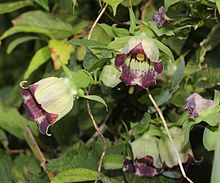Codonopsis lanceolata
| Codonopsis lanceolata | |
|---|---|

| |
| Scientific classification | |
| Kingdom: | Plantae |
| Clade: | Tracheophytes |
| Clade: | Angiosperms |
| Clade: | Eudicots |
| Clade: | Asterids |
| Order: | Asterales |
| Family: | Campanulaceae |
| Genus: | Codonopsis |
| Species: | C. lanceolata
|
| Binomial name | |
| Codonopsis lanceolata | |
Codonopsis lanceolata, also called deodeok (더덕), todok, or lance asiabell,[1] is a flowering plant native to East Asia (China, Japan, Korea, and the Russian Far East). It is a variety of bonnet bellflower.
Description
Codonopsis lanceolata is a hardy perennial climber that grows up to 1.5 m tall. It has bell-shaped flowers that are purple inside.[2]
-
Seeds
-
Roots
Cultivation
Codonopsis lanceolata grows in moist areas in woodland on low hills or mountains at an elevation of 200–1600 m. The plant grows best in light and medium-well drained soils with plenty of moisture with a neutral to semi-acidic pH and in full sun to semi-shade.[3][4] It will grow to a height of 5 feet (1.5 m) high, blooming in late summer, but it dies back each winter.[2] The flower blooms from August to September, and the seeds ripen from September to October.[2]
The plant may be propagated by seeds that are surface-sown onto
The plant is grown commercially in
Uses
Culinary
Korea
The roots of Codonopsis lanceolata, deodeok (더덕) in Korean, are used in
-
Washed and peeled deodeok
-
Deodeok-gui (grilled deodeok)
-
Deodeok salad withyujadressing
-
Deodeok-kimchi
Medicinal
Codonopsis lanceolata is used in Korean and
Etymology
The
References
- ISBN 978-89-97450-98-5. Archived from the original (PDF) on 25 May 2017. Retrieved 6 December 2016 – via Korea Forest Service.
- ^ a b c d "Codonopsis lanceolata". Missouri Botanical Garden. Retrieved 1 February 2024.
- PMC 6843391.
- ^ a b "Codonopsis lanceolata - (Siebold.&Zucc.)Trautv". Plants for a Future. Retrieved February 1, 2024.
- ^ "청청청 횡성더덕농가" [Cheongcheongcheong Hoengseong Deodeok Farmhouse]. 청청청 횡성더덕농가 (in Korean). Retrieved February 1, 2024.
- ^ a b Gryrus, Andrew. "Bellflowers". www.clovegarden.com. Retrieved February 1, 2024.
- ^ Jeong, Jaehong. "더덕구이" [Deodeokgui]. terms.naver.com (in Korean). Hyung Seul Publication. Retrieved 19 March 2020.
- ^ "Korean Food Culture Series - Part 1, Korean Food". Korean Tourism Organization. Archived from the original on 2008-04-11.
- ^ Price, Laura (May 13, 2016). "Five Korean ingredients from the stars of KoreaNYC". 50 Best.
- ^ Dharmananda, Subhuti (June 2007). "Codonopsis: Medicine and Food". Institute for Traditional Medicine.
- PMID 25099952.






